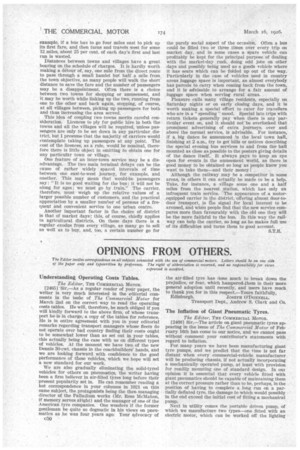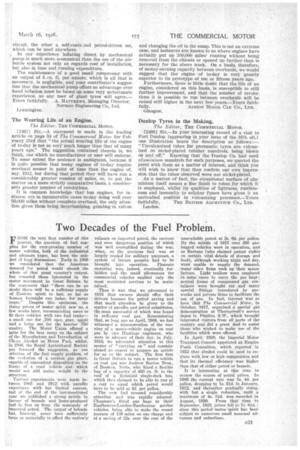OPINIONS FROM OTHERS.
Page 56

Page 57

If you've noticed an error in this article please click here to report it so we can fix it.
The Editor invites corresPondence on all subjects connected with the use of commercial motors. Letters should be on one side of the paper only and typewritten by preference. The' right of abbreviation is reserved, and no responsibility for views
expressed is accepted.
Understanding Operating Costs Tables.
The Editor, THE COMMERCIAL MOTOR.
[2465] "Sir,—As a regular reader of your paper, the writer is very much interested in the editorial comments in the issim of The Commercial Motor for March 2nd on the correct way to read the operating costs tables. He will, therefore, be much obliged if you will kindly forward to the above firm, of whose transport he is in charge, a copy of the tables for reference. He is in entire agreement with you in your editorial remarks regarding transport managers whose fleets do not operate over bad country finding their costs ought to be somewhat lower than as set out in your tables, this actually being the case with us on different types of vehicles. At the moment we have two of the new Dennis 30-cwt, chassis in the coachbuilders' hands, and we are looking forward with confidence to the good performance of these vehicles, which we hope will set a new standard for our work.
We are also gradually eliminating the solid-tyred vehicles for others on pneumatics, the writer having been a firm believer in air-filled tyres long before their • present popularity set in. He can remember reading a hot correspondence in your columns in 1921 on this same subject, the protagonists being the then managing director of the Palladium works (Mr. Ross McMahon, if memory serves alight) and the manager of one of the American tyre companies. One wonders if the former gentleman be quite so dogmatic in his views on pneumatics as he was four years ago: Your Advocacy of
c50 the air-filled tyre has done much to break down the prejudice, or fear, which hampered-them in their more general adoption until recently, and users have much, to thank you for in this respect.—Yours faithfully, Edinburgh. JOSEPH O'DONNELL, Transport Dept., Andrew S. Clark and Co.
The Inflation of Giant Pneumatic Tyres.
The Editor, THE COMMERCIAL MOTOR. [2466] Sir,—The article on giant pneumatic tyres appearing in the issue of The Commercial Motor of February 16th has come to our notice, and we cannot pass without comment your contributor's statements with regard to inflation.
For many years we have been manufacturing giant tyre pumps, and we predict that the time is not far distant when every commercial-vehicle manufacturer will be producing chassis, if not actually incorporating a mechanically operated pump, at least with provision for readily mounting one of standard design. In out opinion it is essential that every vehicle fitted with giant pneumatics should be capable of maintaining them at the correct pressure rather than to be, perhaps, in the position of having to complete a long run on a partially deflated tyre, the damage to which would possibly in the end exceed the initial cost of fitting a mechanical pump.
Next in utility comes the portable driven pump, of which we manufacture two types—one fitted with an electric motor, which can be worked off the lighting circuit, the other a self-conta:ned petrol-driven set, which can be used anywhere.
\, In our experience inflating direct by mechanical pump is much more economical than the use of the airbottle system not only as regards cost of installation, but also in time and running expenditure.
The maintenance of a good small compressor with an output of 3 cu, ft. per minute, which is all that is necessary, is negligible, and your contributor's suggestion that the mechanical pump offers no advantage over hand inflation must be based on some very unfortunate experience, as any user of giant tyres will agree.— Yours faithfully, _A. MATTEIEWS, Managing Director, Norman Engineering Co., Ltd. Leamington.
The Wearing Life of an Engine.
The Editor, THE COMMERCIAL MOTOR.
12467I Sir,—A statement is made in the leading article on page 34 of The Commercial Motoi for February 23rd that "the actual wearing life of the engine of to-day is not so very much longer than that of many years ago." The suggestion contained therein is, we -think, one which no manufacturer or user will endorse. To some extent the sentence is ambiguous, because it is quite possible that many engines of to-day require overhaul sooner in point of time than the engine of, say, 1912, but during that period they will have run a considerably greater number of miles, or, to put the matter on a more strictly comparative basis, a considerably greater number of revolutions.
it is common knowledge that bus engines, for instance, are in innumerable cases to-day doing well over 50,000 miles without complete overhaul, the only attention given them being decarbonizing, grinding-in valves and changing the oil in the sump. This is not an extreme ease, and instances are known to us where engines have actually put up 100,000 miles' running without being removed from the chassis or opened up farther than is necessary for the above work. On a basis, therefore, of money-earning capacity between overhauls, we would suggest that the engine of to-day is very greatly superior to its prototype of ten or fifteen years ago. Furthermore, there is little doubt that the life of an engine, considered on this basis, is susceptible to still further improvement, and that the number of revolutions it is possible to run between overhauls will be raised still higher in the next fewyears.—Yours ALBION MOTOR CAR CO., LTD.
Glasgow.
Dunlop Tyres in the Making.
The Editor, THE COMMERCIAL Moron.
[2468] Sir,—In your interesting record of a visit to Fort Dunlop (appearing in your issue of the 16th ult.) one illustration bears the description as follows:— " T_Tnvulcanized tubes for pneumatic tyres are vulcanized on nickel-plated tubular mandrels, being blown on and off." Knowing that the 'Dunlop Co. had used aluminiuni mandrels for such purposes, we queried the point with them as a matter of interest, and think you will wish to know that they confirm our own impression that the tubes observed were not nickel-plated.
As a matter of fact, the exceptional surface of aluminium itself means a fine finish to tubes for which it is employed, whilst" its qualities of lightness, rustlessness and immunity to sulphur fumes have given it an unrivalled position in vulcanizing processes.—Yours faithfully, THE BRITISH ALUMINIUM CO., LTD. London.


























































